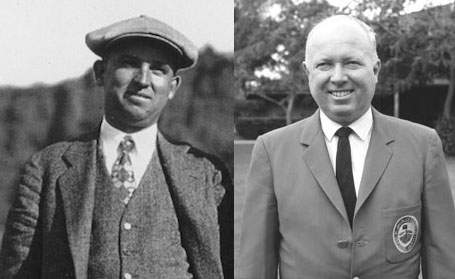
William Park “Billy” Bell was born in 1886 and raised on a Pennsylvania farm. In 1911, after a stint at Duff’s College, Pittsburgh, Billy was hired by the Annandale Country Club as a greenkeeper and caddie master. By 1917, he was the official Ground Foreman, working with Donald Ross associate Walter Fovargue, building a new Annandale golf course. Architect William Watson was hired in 1919 to remodel the course in grass, and Billy Bell supervised and built it.
Billy Bell competed in local golf tournaments, finishing in the top ten out of 385 entries at Griffith Park for the Red Cross in 1917, and coming sixth in an invitational at Annandale in 1919.
Billy Bell left Annandale to work with Chicago legends George O’Neil and Jack Croke at the new 54-hole Pasadena Golf Club (Altadena) by May of 1920. Soon after, Croke and Bell built Mountain Meadows and rebuilt Annandale and Rancho, after which Billy went on to build new courses with Max Behr at Montebello and Rio Hondo, and then with George C. Thomas Jr. at Griffith Park, Ojai Valley, La Cumbre, Bel-Air, Riviera and Los Angeles North.
Billy Bell designed and built over seventy golf courses, including Palos Verdes, Woodland Hills, Chevy Chase, Castlewood, Sunnyside, Oahu, Catalina, Brookside, San Clemente, San Diego, La Jolla, Western Ave., (Chester Washington), Lakewood, Recreation Park, Stanford, Apple Valley, and he worked with William Johnson on Rancho Park, Balboa/Encino, Alondra Park, and Singing Hills.
“By the 1930s Bell had earned a reputation as the most prolific architect in the west.”
He was a pioneer in golf course construction, irrigation and landscaping, and an expert agronomist, who was also in charge of the turf at the Pasadena Rose Bowl and the Los Angeles Coliseum, where he was turf advisor for the 1932 Los Angeles Olympics.
“During World War II, he served as a turf consultant to the U.5. Army Corps of Engineers.”
After the war, Billy Bell designed and built a number of golf courses for the veterans, at his own expense, including at Pearl Harbor, Guam, Long Beach, West Los Angeles, Van Nuys, Santa Ana, Marine Memorial, and Camp Pendleton.
“In 1946 he was awarded a commendation by the Southern California chapter of the PGA for his effort in creating courses for wounded servicemen.”
His partnership with his son, Billy Bell Jr. (William Francis Bell), started after junior’s return from the war, where he was a Yeoman on the Aircraft Carrier USS Block Island (CVE-21 & CVE-106) in both the Atlantic and Pacific campaigns, reaching the rank of Major.
After the war, father and son formed a new company and started working together. As Billy slowed down, junior sped up. By the early 1950s, Billy Bell Jr. was clearly carrying on the family tradition. He would go on to design, build and renovate, over 100 golf courses.
Their work together included, Tamarisk, Torrey Pines, Tucson, Bakersfield, Buena Ventura, Newport Beach, and Rolling Hills, while on his own, Billy Bell Jr. gave us Malibu, Industry Hills, Antelope Valley, California, Harbor Park, Jurupa Hills, Monarch Beach, Newport Beach, Palm Desert, Saticoy, Skylinks, Knollwood, Heartwell, Los Verdes, Lake Arrowhead, Sandpiper, Whittier Narrows and Soule Park, to name but a few.
Billy Bell and Billy Bell Jr., are the two most important golf course architects in Southern California history. Billy Bell was a founder and 1952 president of the American Society of Golf Course Architects, and Billy Bell Jr., was president five years later. Their induction into the 2017 Hall of Fame is a long overdue reward for their magnificent contribution to the sport of golf in our state.
Written for the 2017 SCGA Hall of Fame induction of Billy Bell and his son Billy Jr. by John Jones.
©2017-2019 golfhistoricalsociety and jibjones All Rights Reserved.
